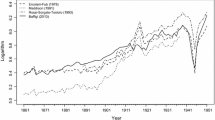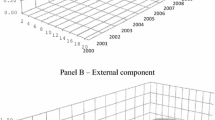Abstract
This paper considers the relationship of the Nordic business cycle to the world business cycle using annual output data spanning 1870–1988. The paper studies the Nordic and a set of non-Nordic countries separately and finds evidence for both a Nordic and a world business cycle. Output movements in the individual Nordic countries are connected through the Nordic business cycle and are less affected by the world business cycle. There is no significant change in the behavior of the business cycle in the Nordic countries between 1873–1913 and 1948–1988.
Similar content being viewed by others
References
Backus, D. K. and P. J. Kehoe (1989) “International Evidence on the Historical Properties of Business Cycles,” Working Paper 402R, Federal Reserve Bank of Minneapolis.
Baxter, M. and A. C. Stockman (1989) “Business Cycles and the Exchange-Rate Regime,”Journal of Monetary Economics 23, 377–400.
Bergman, M. and L. Jonung (1990) “The Business Cycle Has Not Been Dampened: The Case of Sweden and the United States 1873–1988,” Research paper 6234, Stockholm School of Economics.
Bordo, M. D. (1989)Money, History, and International Finance: Essays in Honor of Anna J. Schwartz. Chicago: University of Chicago Press and NBER.
Bordo, M. D. and A. J. Schwartz (1984)A Retrospective on the Classical Gold Standard, 1821–1931. Chicago: University of Chicago Press and NBER.
Campbell, J. Y. and N. G. Mankiw (1989) “International Evidence on the Persistence of Economic Fluctuations,”Journal of Monetary Economics 23, 319–333.
Dellas, H. (1986) “A Real Model of the World Business Cycle,”Journal of International Money and Finance 5, 381–394.
Feinstein, C. (1972)National Income, Expenditure, and Output of the United Kingdom 1855–1965. Cambridge: Cambridge University Press.
Gerlach, S. (1988) “World Business Cycles under Fixed and Flexible Exchange Rates,”Journal of Money, Credit, and Banking 20, 621–632.
Gerlach, S. (1990) “International Business Cycles: A Survey of Recent Empirical Research,”Finanzmarkt und Portfolio Management 4, 320–331.
Gerlach, S. and J. Klock (1988) “State-Space Estimates of International Business Cycles,”Economics Letters 28, 231–234.
Gordon, R. J. (1986)The American Business Cycle: Continuity and Change. Chicago: University of Chicago Press and NBER.
Harvey, A. C. (1981)Time Series Models. Deddington: Philip Allan.
Hjerppe, R. (1989)The Finnish Economy 1860–1985: Growth and Structural Break. Helsinki: Bank of Finland.
Jörberg, L. (1961)Growth and Fluctuations of Swedish Industry 1869–1912 Stockholm: Almqvist and Wiksell.
Jörberg, L. (1970) “The Industrial Revolution in Scandinavia 1850–1914.” In C. M. Cipolla (ed.),The Fontana Economic History of Eruope: The Emergence of Industrial Societies. London: Collins.
Jörberg, L. (1973) “The Nordic Countries 1850–1914.” In C. M. Cipolla (ed.),The Fontana Economic History of Europe: The Emergence of Industrial Societies. London: Collins.
Jörberg, L. and O. Krantz (1976) “Scandinavia 1914–1970.” In C. M. Cipolla (ed.),The Fontana Economic History of Europe: Contemporary Econmies. London: Collins.
Klovland, J. T. (1989) “A Chronology of Cycles in Real Economic Activity for Norway 1867–1914,”Scandinavian Economic History Review 37, 18–38.
Krantz, O. and C-A Nilsson (1975)Swedish National Product 1861–1970. Lund: Gleerup.
Mitchell, B. R. (1975)European Historical Statistics 1750–1970. London: MacMillan.
Norwegian Central Bureau of Statistics (1965)National Accounts 1865–1960. Oslo: Norwegian Official Statistics XII 163.
Okhawa, K., N. Takamatsu and Y. Yamamoto (1974)Estimates of Long-Term Economic Statistics of Japan Since 1868, Vol 1: National Income. Tokyo: Tokyo Keizai Shiposha.
Quah, D. (1986) “How Are International Business Cycles Also Alike?” mimeo, MIT.
Romer, C. (1989) “The Prewar Business Cycle Reconsidered: New Estimates of GNP 1869–1908,”Journal of Political Economy 21, 1–37.
Sheffrin, S. M. (1988) “Have Economic Fluctuations Been Dampened? A Look at the Evidence Outside the United States,”Journal of Monetary Economics 21, 73–83.
Swoboda, A. (1983) “Exchange Rate Regimes and U.S.-European Policy Interdependence,”IMF Staff Papers 30, 75–102.
Author information
Authors and Affiliations
Rights and permissions
About this article
Cite this article
Bergman, M., Gerlach, S. & Jonung, L. External influences in Nordic business cycles, 1870–1988. Open Econ Rev 3, 1–22 (1992). https://doi.org/10.1007/BF01886178
Issue Date:
DOI: https://doi.org/10.1007/BF01886178




